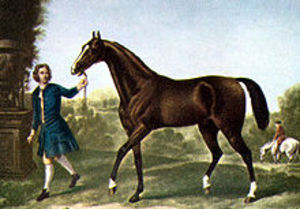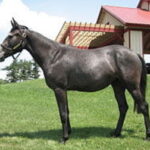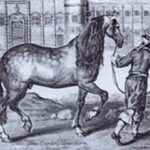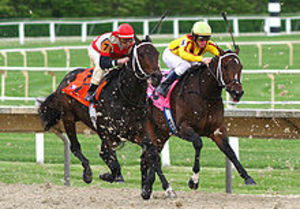Thoroughbreds got their name not because they were purebreds, but that they were thoroughly bred for speed. So, calling any purebred animal a “Thoroughbred” is a mistake. According to Storey’s Illustrated Guide to 96 Horse Breeds of North America (Storey Publishing, 2005), Thoroughbreds were often known as “English horses” during Colonial America.
Thoroughbreds were developed in the 1700s in England for the express purpose of racing. They have also been used for other horse sports, for cavalry, and to cross with other breeds. There are vast differences within the breed, even though the stud book was closed in the 1800s. The breeding principle is “breed the best to the best and hope for the best,” which has led to the creation of a remarkably fast, remarkably beautiful, and remarkably fragile animal.
Origins
It is generally thought that the Thoroughbred descended from three Arab stallions, only that those stallions probably were not Arabian, but were most likely Turkoman or Akhal-Teke. Surviving paintings of the Darley Arabian, for example, show a horse more like an Akhal-Teke than an Arabian. Unfortunately, all foals and horses captured in war from anywhere in the Middle East or Northern Africa area were called Orientals, Arabs, or Barbs. The words were used indiscriminately.
The Holy Trinity of the Thoroughbred breed are the Byerly Turk, the Godolphin Arabian (or Godolphin Barb), and the Darley Arabian. The Darley has been the most dominate force in Thoroughbred breeding. About 95 percent of all Thoroughbreds alive today trace their ancestry back to him. One of his most influential descendants of modern times was the 1964 Kentucky Derby winner Northern Dancer, who is in the pedigrees of 60 percent of today’s Thoroughbreds.
But where do Thoroughbreds get their incredible speed? Not from any of the foundation sires, according to recent studies in Ireland of Thoroughbred DNA. The “speed gene” was from one unknown, anonymous mare that was bred in Britain, foaled in Britain, and raced in Britain just over 300 years ago. The mare may have been part or mostly Shetland — one of the original racing breeds of the UK.
General Appearance
The Thoroughbred is usually a tall, slim horse averaging 16 hands high, but some Thoroughbreds can be under 15 hands, while others can be built like a heavy cob. They generally have wide eyes, a deep chest, and a low-set tail. The profiles of their heads are generally straight, although dished and Roman noses do occur. They have thin manes and tails.
They come in all usual solid horse colors, with bay predominating. However, purebred Thoroughbreds can come in very rare colors such as palomino, sabino (a type of pinto pattern), and white (not albino, not light grey, but white). Perhaps the most famous strangely colored Thoroughbred of modern times was the mare Patchen Beauty.
Maturity
Thoroughbreds do mature earlier than many other breeds of horses, but many are not fully mature until they are five years old. Unfortunately, racing Thoroughbreds are often asked to work like adults when they are only two or three years old because of money issues. Racetrack injuries can often lead to the horse being crippled for life or put to an early death.
Thoroughbreds do live away from the track, especially if they are allowed to mature before they are heavily worked. They can be used for all horse sports, especially three-day eventing, hunting, dressage, and jumping. Many Thoroughbreds are bred and trained for jumping, such as the immortal Gem Twist. One chestnut ex-racehorse, who came in last in a Breeder’s Cup race, became a successful student riding horse for children. Thoroughbreds can live to be over 30 years old, but are often euthanized or slaughtered by owners not willing or able to care for an older horse.
Additional References
- International Encyclopedia of Horse Breeds Bonnie Hendricks. University of Oklahoma Press, 1995.
- Storey’s Illustrated Guide to 96 Horse Breeds of North America. Judith Dutson. Storey Publishing, 2005.
- The Official Horse Breeds Standard Book. Fran Lynghaug. Voyageur; 2009.
- “The cosmopolitan maternal heritage of the Thoroughbred race horse breed shows a significant contribution from British and Irish native mares.” M. A. Bower, et al. October 6, 2010.







